

 |
||
 |
||
 |
| Keys
word: Bahia, Brazil, Dungsia, Dungsia brevicaulis, Dungsia
marcaliana, taxonomy Abstract: A new species of Dungsia (Orchidaceae), found by Sidnei Marçal, in southern Bahia (Brazil), is described. |
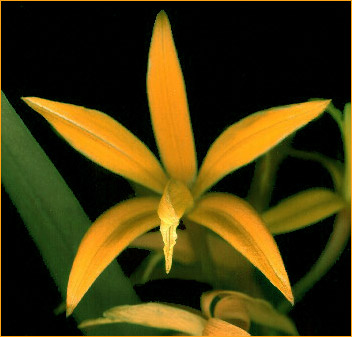 |
The
genus Dungsia has been established by Chiron & Castro Neto
(2002) in order to accommodate three species before belonged to the genus
Laelia. The taxon in question was, in fact, already known by one
of us (MC) since l985, before being recently re-collected but some important
doubts about the identification remained. Based on the studies of the
species of the genus Dungsia done by one of us (GC) and due to
the verification that this plant does not coincide with Dungsia brevicaulis
(H.J. Jones) Chiron & V. P. Castro, we got to the conclusion that
it is really a good species. |
| The schedule 1 and the plate 1 complete the explanation about the differences. They were established based on personal observations as well on data of the literature, mainly Jones (l972), Pabst & Dungs (l975) and Withner (l990) |
|
Dungsia
brevicaulis
|
Dungsia harpophylla
|
Dungsia
marcaliana
|
|
| length of the pseudobulbs regarding the leaves. |
more than twice shorter
|
almost
twice longer
|
slightly
longer
|
| shape of the leaves |
in
general larger
|
narrow
|
wide
|
| number of flowers by inflorescence. |
2-3
|
6-8
|
4-6
|
| position of the lateral sepals. |
close,
almost parallel to the lip
|
45º
from the lip
|
45º
from the lip
|
| width of the sepals and petals |
7-9
mm
|
<6
mm
|
6-7
mm
|
| mid-lobe
of the lip |
narrower,
tapering off.
|
widening
from the base, obtuse apex
|
regularly
narrow, acute apex
|
| lateral lobes of the lip |
comparatively
short, separated from the mid-lobe
|
comparatively
short, separated from the mid-lobe
|
comparatively long, overlapping the mid-lobe
|
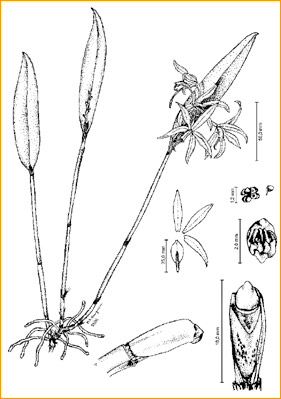 |
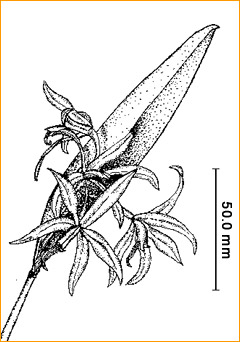 |
|
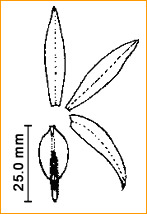 |
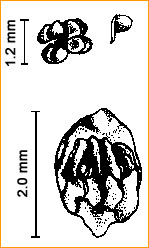 |
|
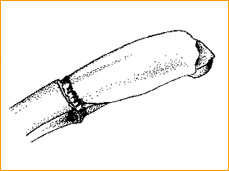 |
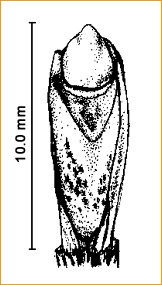 |
| Schedule
1: comparison of the three species of Dungsia Plate1: comparison of the lips of the species of Dungsia [Based on Withner (l990) and on personal observations] |
| Dungsia
marcaliana Campacci & Chiron in Richardiana II (2) - mars 2002,
75/79 Herba epiphytica, rhizomate breviusculo, pseudobulbis cylindraceis, tenuibus, 11,0-15,0 x 0,3-0,4cm, unifoliatis ; foliis lanceolatis, leviter curvatis, coriaceis, 10,0-13,0 x 1,5-1,8cm ; floribus mediocribus, luteis vel aurantiacis ; sepalibus leviter retroflexis, dorsale lanceolato, 3,2 x 0,6cm et lateralibus falcatis, 2,8 x 0,7cm ; petalibus lanceolatis, leviter retroflexis, 3,2 x 07,cm ; labello profunde tribolato, in centrum bicarinato, leviter retroflexo, 2,5 x 1,0cm, lobo medio angusto, ondulatimarginato ; columna lutea , 1,0 x 03cm ; 8 pollinia. |
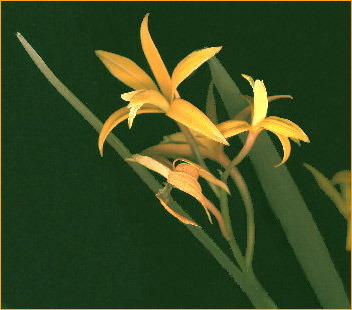
|
Type: Brazil, Bahia, in the surroundings of Buerarema city. |
| Description: Epiphytic plant, sub-caespitose, with cylindrical pseudobulbs, reaching until 15,0 cm of length and 0,4 cm widths, unifoliate, lanceolate, coriaceous leaves, reddish in back, with until 13,0 cm length by 1,8 cm width in the central part, apical short inflorescence, bearing from 4 to 6 simultaneous flowers , small orange or yellowish flowers; lightly curved sepals, the dorsal is lanceolate, with 3,2 cm length by 0,6 cm width and the lateral sepals are falcate with 2,8 cm de length by 0,7 cm width; the lanceolate petals are also slightly curved, with 3,2 cm width by 0,7 cm width; lip extremely tri-lobate, with 2 lowered keel in the middle, with 2,5cm length by 1,0 cm width, sharp mid-lobe lobo with undulated margins; column in the same color of the other segments, with 1,0 cm length by 0,3 cm width; 8 pollinia. |
| Distribution - Habitat: South of Bahia, next to Buerarema city. Humid wood of the Atlantic Forest, endemic to a small region, in altitude varying from 200 to 300 meters. Blooming season: Brazilian summer. |
| Botanical plate and photography: Marcos Antonio Campacci |
|
Bibliography: Jones, H . J. l972. A new species of the orchid genus Hoffmannsegella. Rhodora, Vol 74:283-286. Pabst, G. F. * F. Dungs, l975. Orchidaceae Brasiliensis, vol. I. Withner, C.L., l990. The Cattleyas and Their Relatives. Vol 2: The Laelias. Timber Press, Portland, Oregon. |
|
Any
kind of reproduction of any type of material of this site - texts, lay-out,
photos, images and others - is strictly forbidden without the previous
written permission of the authors. Any solicitation or information should be done by the e-mail bo@sergioaraujo.com
|